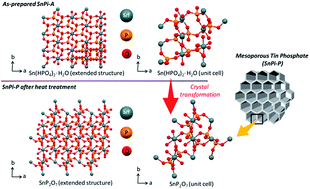Unique nanocrystalline frameworks in mesoporous tin phosphate prepared through a hydrofluoric acid assisted chemical reaction†
Abstract
A mesostructured tin phosphate (SnPi) material has been prepared in the presence of an amphiphilic block copolymer (F127), tin chloride (SnCl4), and phosphoric acid (H3PO4) in an ethanol–water mixed solvent medium. The mesoporous SnPi material, with a large pore diameter (7.4 nm), nanocrystalline walls, a high surface area (310 m2 g−1), and a unique flake-like particle shape, is successfully synthesized by a two-step heat treatment of the parent mesostructured SnPi under flowing N2 gas followed by flowing air. Under moderate conditions (293 K and 60% relative humidity), our mesoporous SnPi shows 6.5 times more proton (H+) conductivity compared to its non-porous/bulk analogue (SnPi-B), due to its higher surface area and unique nanocrystalline porous structure enriched with free O–H groups. The preliminary electrochemical properties of our crystalline mesoporous SnPi as an anode for lithium-ion batteries (LIBs) have been studied as well, which exhibits good reversible specific capacity with good cycling stability and excellent capacity retention of 92%.


 Please wait while we load your content...
Please wait while we load your content...